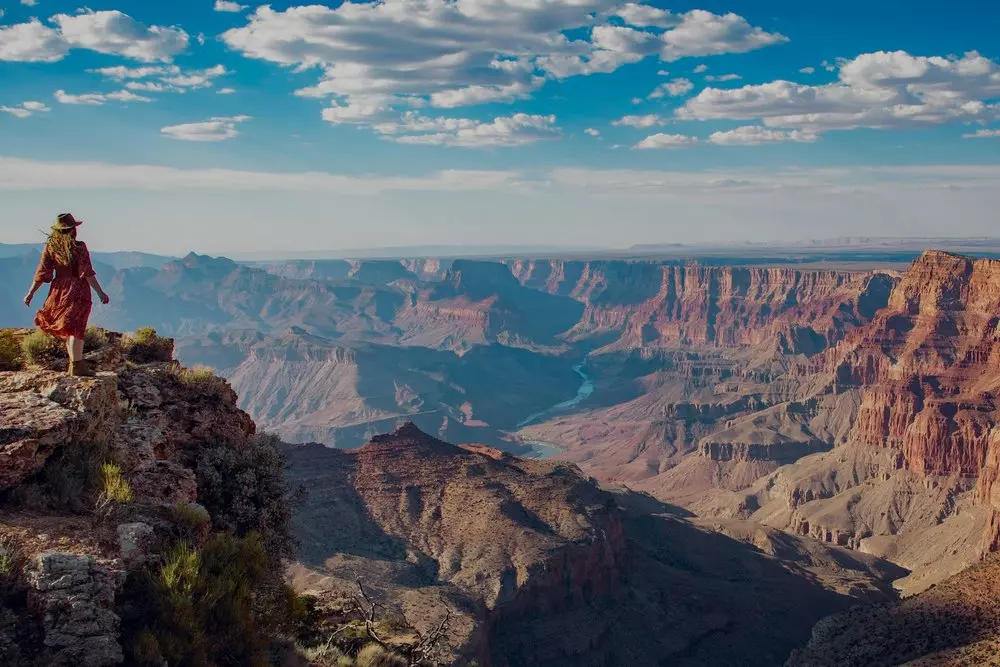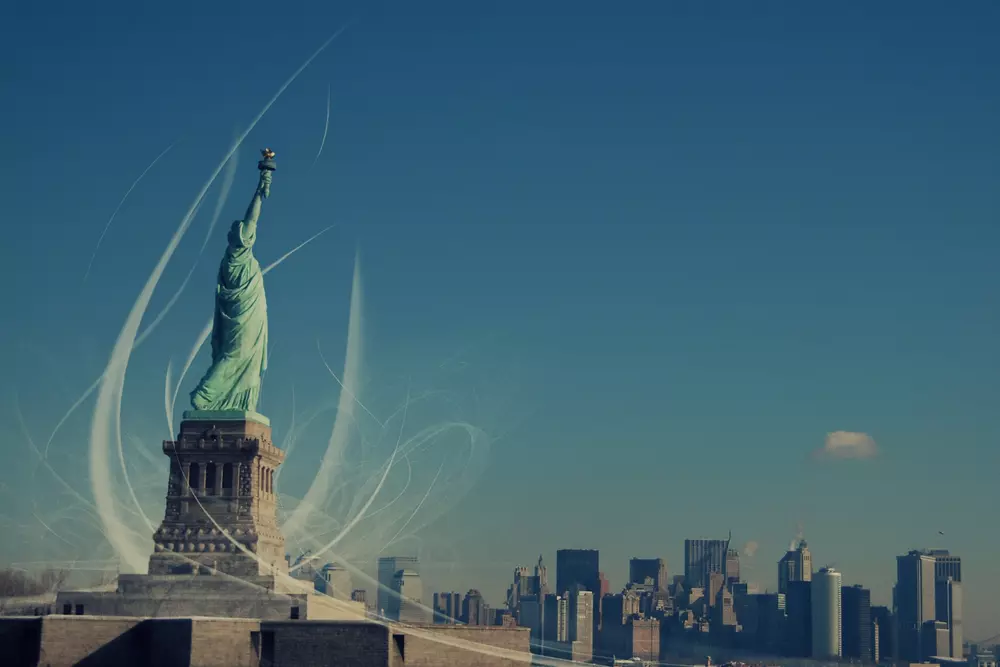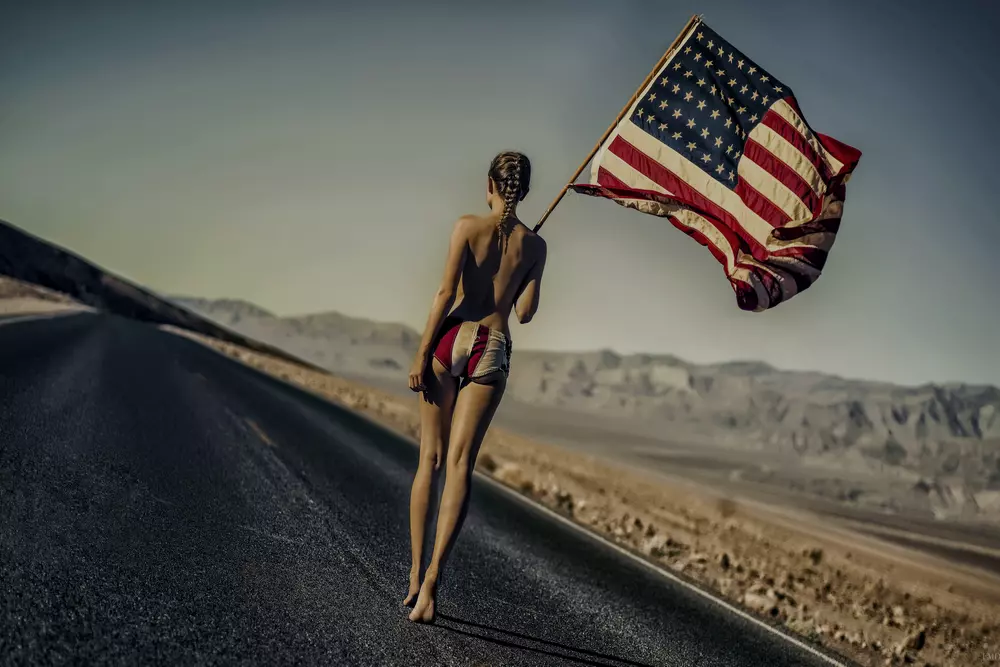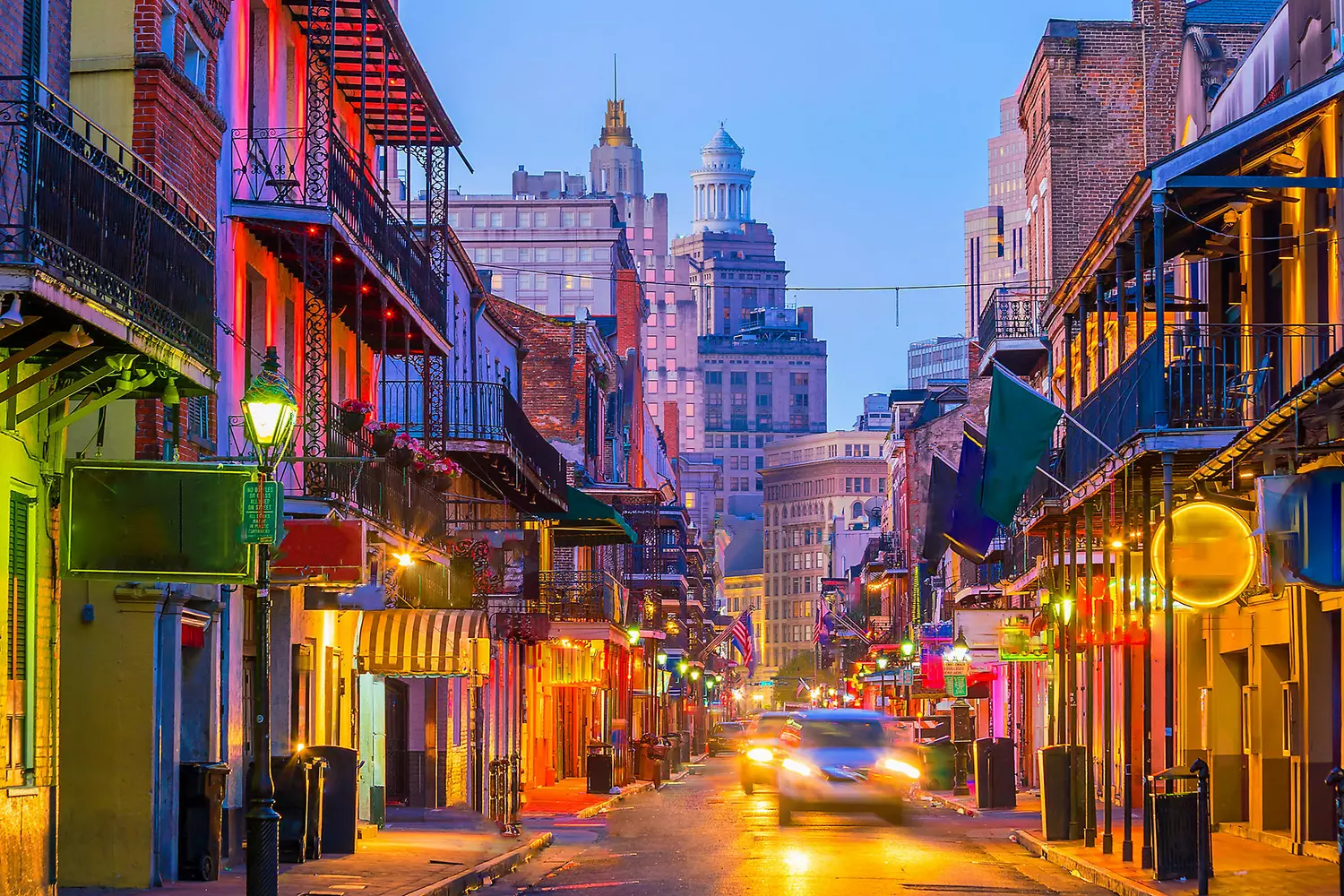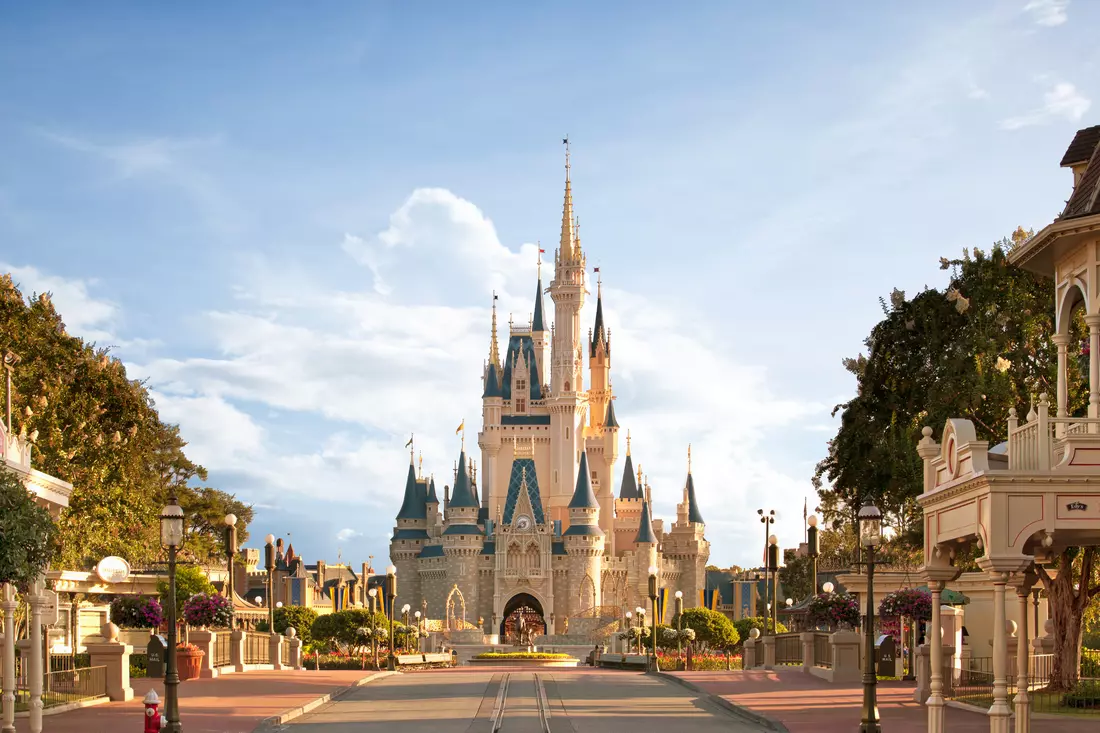When you first see Monument Valley, it feels as if time has stopped. The air shimmers from the heat, the horizon dissolves in a haze, and amidst the endless red desert rise colossal sandstone towers, like ancient guardians of the Earth. Their peaks seem to touch the sky, and the shadows at sunset turn purple, like brushstrokes from the artist who first painted America in its original colors.
At that moment, you suddenly realize that this landscape feels familiar your whole life, even if you’ve never been here. You’ve seen it on the screens of old westerns, in John Ford films, where a rider in a hat slowly disappears down a red road. You’ve seen it in music videos, postcards, commercials — for these very rocks and plateaus have become the symbol of the Wild West, the America that generations dreamed about.
Monument Valley is not just a beautiful place. It is a living legend, carved in stone. There is no need to invent anything here: nature itself has created scenery worthy of cinema. Every peak has its own name and story, every curve of the landscape holds the imprint of millennia.
Standing at the edge of a viewpoint, you feel a strange sensation — as if there is an ancient connection between you and this landscape. At first, it seems unreal: the silence rings, the air is dense, and the light is almost golden. Then comes the realization — you are truly in the heart of America, as it was long before roads and cities appeared.
Monument Valley is a place where the earth talks to time. Here the winds tell stories, and sunsets feel slower, as if the sun does not want to leave. It is sacred land for the Navajo people, who have lived among these rocks for centuries and believe that the spirits of their ancestors dwell within them.
For some travelers, it is just another stop on a list of sights. For others, it is almost a pilgrimage.
Because Monument Valley is not about miles or routes.
It is about a feeling. About how red dust settles on your boots, how the sun tickles your shoulders, and how inside, everything becomes truly quiet.
Welcome to Monument Valley — a place where reality becomes myth, and every sunset is a page in a great story.
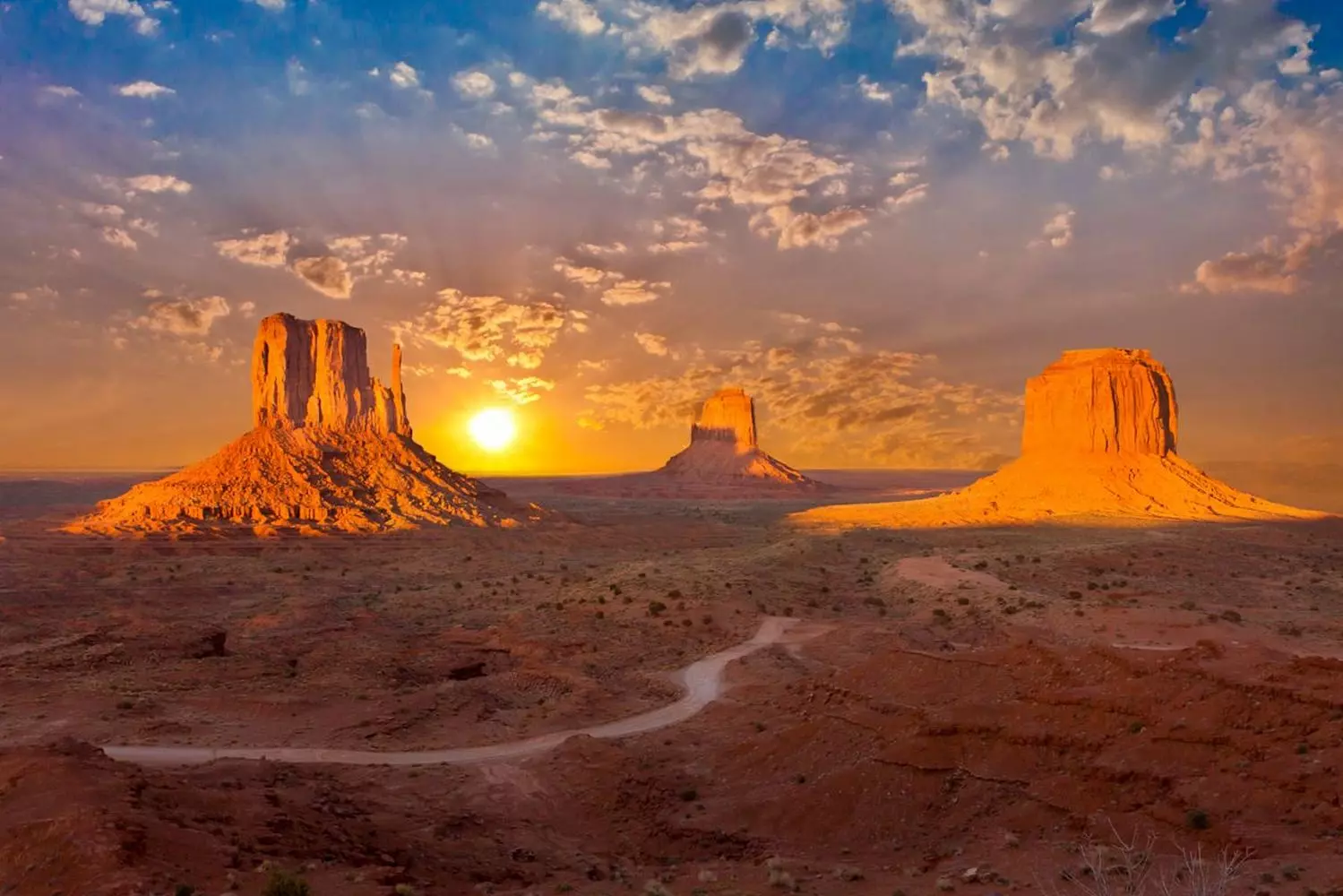
Monument Valley is one of the most popular filming locations in Hollywood history. Not only was it featured in The Searchers, but also in Back to the Future Part III, Mission: Impossible 2, Forrest Gump, as well as dozens of commercials and music videos.
On the Border of States and Time: Where Monument Valley Is Located
Monument Valley is not just a point on the map. It is a place where state and time boundaries converge, and the red rocks seem to mark the limits of human stories. Geographically, Monument Valley sits right on the dividing line between Arizona and Utah, but in essence, it is also the heart of the Navajo Nation — a living cultural landscape where modern tourists intersect with ancient traditions.
- 01. Map in a nutshell — scale and coordinates
- The valley covers approximately 370 km² — enough to explore over several days, not just at a glance.
- Individual monoliths (buttes and mesas) reach 300–320 meters in height, making them visible from afar and creating the effect of “sudden appearance” — first the road, then the giants.
- GPS coordinates of the valley’s central area: 37.0°N, 110.0°W (approximate). These numbers help you quickly locate the place on any map or GPS device.
- 02. How the area is organized — not a national park, but a reservation
It’s important to understand: Monument Valley is not a typical national park managed by federal authorities. It is part of the Navajo reservation, where local rules, traditions, and infrastructure apply. This means that land ownership, tours, and some road networks are controlled by the Navajo Nation — and this should be respected. - 03. Climate and seasons
The region is desert-like: summers can be extremely hot with strong solar radiation, while nights are cooler, especially in spring and autumn. Plan clothing in layers, and bring sufficient water and sun protection.
Many travelers note that the roads leading to Monument Valley serve as a kind of “preparation” for encountering the place. The closer you get by car, the more sudden and majestic the view becomes: first, you see isolated columns, then entire rows of monoliths, until finally you are surrounded by stone giants. This gradual unveiling of the landscape turns the first arrival into a true ritual — permanently imprinting the sensation of the “first look” in your memory.
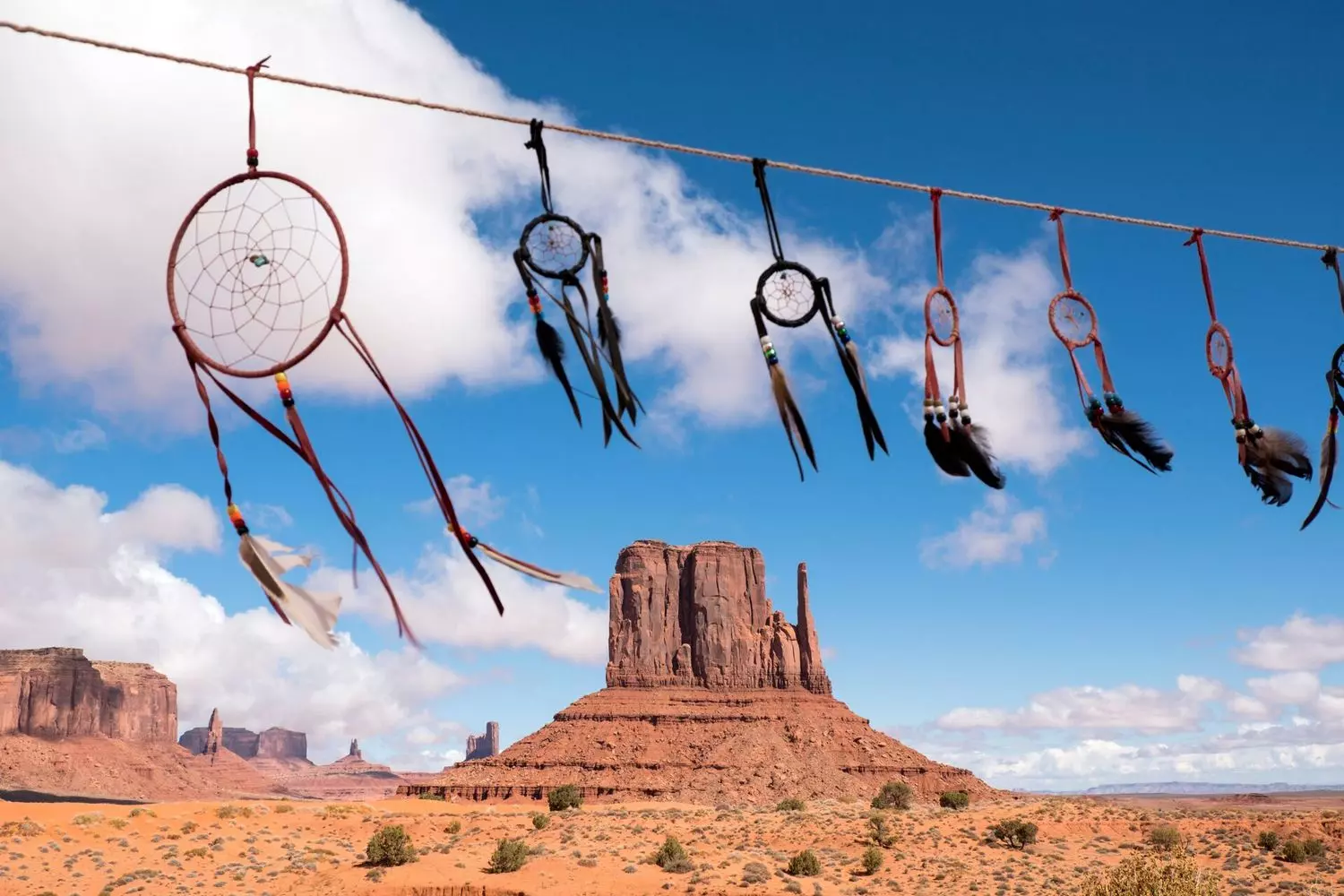
What to See in Monument Valley: Legends, Panoramas, and Roads Leading to Eternity
A journey through Monument Valley is not just sightseeing — it is an encounter with the living symbols of America. Every stone here is recognizable, every turn of the road seems like a frame from a movie. It’s no wonder this valley is called the most cinematic place on the planet. To truly feel its atmosphere, it’s important to know where to stay, where to look, and what not to miss.
- 01. The Mittens and Merrick Butte — the desert’s famous “gloves”
These are the calling cards of Monument Valley. East Mitten, West Mitten, and Merrick Butte form a composition that welcomes every traveler entering the valley.
They are named for their shapes: the first two rocks truly resemble enormous stone gloves raised in a greeting gesture. At sunrise and sunset, these monoliths are especially impressive: shadows fall across the red sand, making the “gloves” seem to come alive.
- Photo tip
The best view is from the Visitor Center platform or from US-163, the road leading directly into the valley. This is the view most often seen on postcards and in films. - Interesting fact
According to Navajo legend, the two “gloves” symbolize the hands of ancient spirits guarding the entrance to the sacred valley.
- 02. John Ford’s Point — where westerns are born
If you’ve ever watched classic Wild West films, you’ve most likely seen this landscape. John Ford’s Point is a viewpoint named after director John Ford, who shot his iconic movies here: Stagecoach, The Searchers, My Darling Clementine, and others.
From here, you get one of the most spectacular views of the valley’s central area: a road stretches below, and in the distance rise stone giants, like frozen heroes from a western. Today, you can often see local Navajo residents offering horseback photo sessions — just like in the old movies.
Tip: the best time to shoot is morning or sunset, when the sun softly lights the rocks from the side. - 03. Totem Pole and Yei Bi Chei — the guardians of dawn
On the eastern edge of the valley rise slender, almost fantastical columns — Totem Pole and Yei Bi Chei. They are unlike typical massive rocks: narrow and elongated, soaring tens of meters into the sky.
For the Navajo, these stone figures are sacred: Yei Bi Chei represent spirits participating in healing ceremonies, while Totem Pole, according to legend, is made up of petrified warriors frozen in anticipation of a new sunrise.
- Best time
Sunrise, when the first rays turn the columns golden-red and the shadows stretch long across the sand. - Access
You can reach the viewpoint via the Valley Drive route, but parts of the road are sandy and uneven, requiring caution.
- 04. Valley Drive — the road through legend
To experience Monument Valley in all its glory, take the Valley Drive — a 27-kilometer loop through the heart of the valley. Along the way, you’ll see almost all the famous landforms: The Mittens, Three Sisters, Elephant Butte, Camel Butte, and more. Important notes:
- The road is unpaved and can be quite rough, especially after rain. A high-clearance or 4x4 vehicle is recommended.
- Traffic is one-way, so allow enough time for stops and photography.
- Average time to complete the loop: 2–3 hours with stops.
Tip: if you are not confident driving on dirt roads, consider a guided tour with a Navajo guide — it’s safer and more enriching. Locals share legends, show hidden arches, ancient settlement traces, and places inaccessible to ordinary tourists.
- 05. Other points to include in your route
- Artist’s Point
One of the most scenic viewpoints with nearly a full view of the valley. Ideal for sunset photos. - Three Sisters
Three slender columns resembling the silhouettes of nuns in prayer. - Elephant Butte
A massive rock shaped like a walking elephant. - Camel Butte
Another natural wonder, shaped like a camel resting among the sands. - Ear of the Wind Arch
A natural arch shaped like an ear, where, according to local belief, you can “whisper a wish.”
Remember: Monument Valley cannot be seen “at a glance.” Its colors change every hour, and the rocks live with the light. At sunrise, they are delicate pink and fragile; during the day, they blaze like molten iron; and in the evening, they turn violet, seeming to dissolve into twilight.
Anyone who has visited even once leaves with the feeling of touching something eternal — the soul of the land, which speaks the language of beauty.
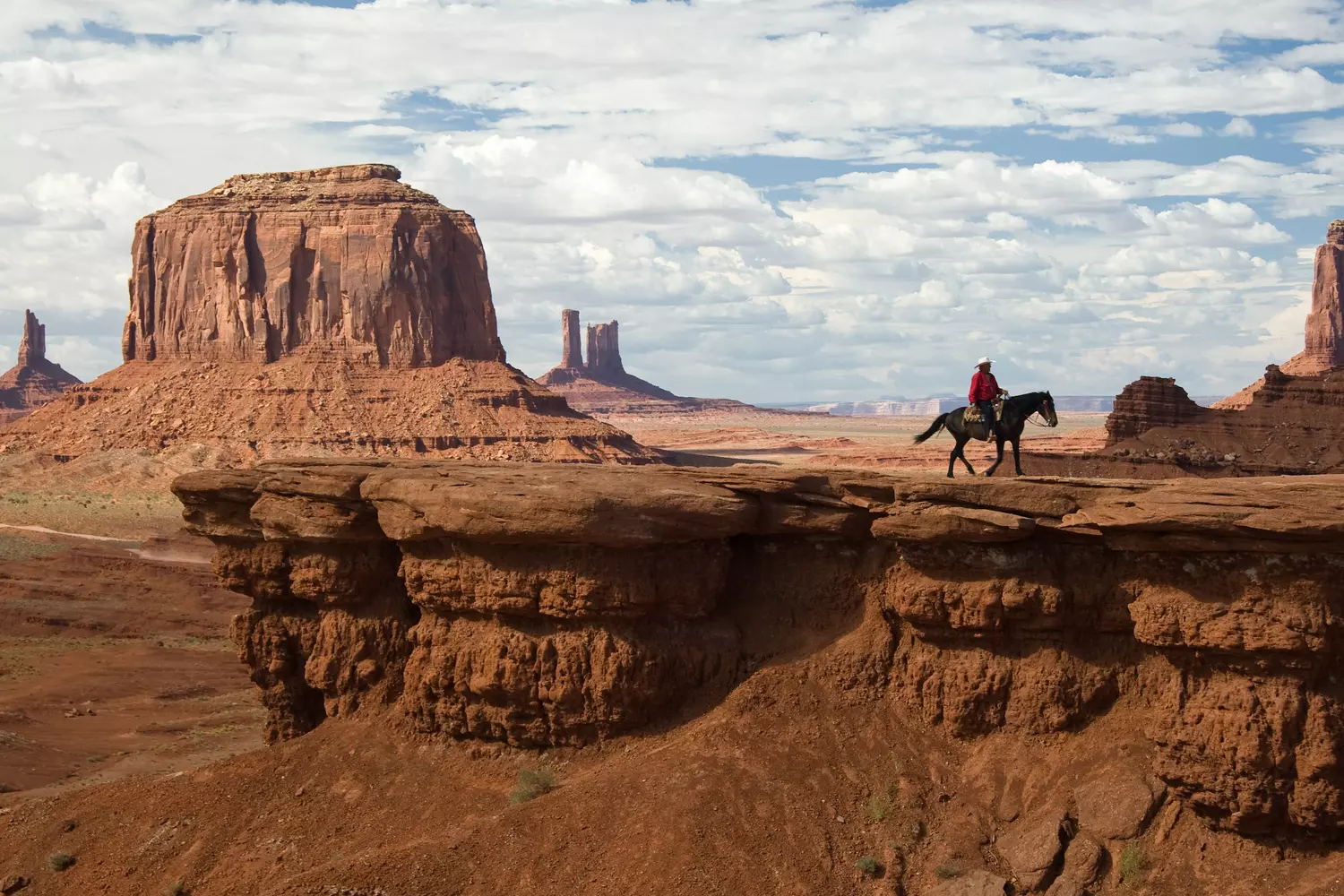
How to Plan a Trip to Monument Valley: Tips, Routes, and Secrets for the Perfect Journey
A journey through Monument Valley is not just a stop on your itinerary; it’s an immersion into legend, where every kilometer of road brings you closer to the living history of America. To make the most of your trip, it’s important to prepare in advance. Monument Valley is a special place: remote, mysterious, with its own rules and atmosphere. Below is a detailed guide to help make your visit truly magical.
- 01. Entry and visit organization
Monument Valley is located within the Navajo Nation, so its own laws and traditions apply. This is important to consider when planning your trip.
- Entrance fee
About $8 per person (cash or card, paid at the Visitor Center entrance). - Hours
Typically from 6:00 AM to 8:00 PM in summer and 8:00 AM to 5:00 PM in winter (check seasonal schedule). - Tours and private excursions
Many scenic and sacred sites are accessible only with a local Navajo guide.
Even experienced travelers will discover a different side of the valley with a guide. Locals share ancient legends, reveal hidden canyons and stone arches inaccessible via official roads. It’s not just a tour — it’s a dialogue with the land and culture.
- 02. Best time to visit
Monument Valley is stunning year-round, but its character changes with the seasons.
- Spring (March–May)
Comfortable temperatures, clear skies, ideal for photography. - Summer (June–August)
Heat can reach +35°C, but sunsets are especially vibrant. Plan trips early in the morning or evening. - Autumn (September–November)
Golden season — soft light, fewer tourists, deep clear skies. - Winter
Cooler, almost no visitors. Snow against red rocks creates a mesmerizing contrast.
Best times of day: sunrise and sunset. The rocks glow fiery-orange, purple, and pink, bringing the landscape to life.
- 03. How to get there
Monument Valley is remote, and that’s what makes the trip special. The most convenient and scenic option is renting a car. Roads are excellent, traffic is minimal, and the views outside the window feel cinematic. Popular routes:
- From Las Vegas — via Page and Kayenta (~640 km, 6–7 hours). Stop by Antelope Canyon, Lake Powell, and Horseshoe Bend along the way.
- From Flagstaff — about 280 km via Cameron and Tuba City. A great choice for those already traveling in Arizona.
- From Sedona — scenic drive through mountains and desert (~400 km).
- From Page — only 200 km, allowing for a day trip to both places.
- 04. US-163 — the road that became iconic
If there is one road to highlight, it is US-163. This highway is a landmark itself. The long straight road stretching into the horizon with rock silhouettes became a meme and the cover image for countless travel guides. Forrest Gump’s famous run took place here — millions of tourists come to recreate this iconic shot. - 05. Practical tips before departure
- Fuel and supplies
Services are limited inside the valley — the nearest major gas stations and stores are usually in Kayenta (AZ) or Mexican Hat (UT). Refuel in advance. - Road conditions
Main approaches and US-163 are paved, but inside the valley many dirt sections exist (Valley Drive and branches). A 4x4 vehicle is safer for some routes. - Connectivity and maps
Mobile signal can be unstable; download offline maps and save coordinates of your hotel and the Visitor Center. - Reservation rules
Some trails and sacred sites require a permit or guide accompaniment. Respect local requests and restrictions. - Paid entry
Access and viewpoints often require a fee or voluntary donation. Check tariffs and payment methods in advance.
- 06. Guided tours
If you want to avoid driving and maximize your experience, choose an organized tour. These trips often include:
- Grand Canyon, Horseshoe Bend, Antelope Canyon, and Monument Valley in one 2–3 day itinerary;
- Air-conditioned transport, accommodation, insurance, and guide assistance;
- Photo stops and stories of the Wild West.
Traveling with a professional guide is not just time-saving, but ensures you see places most tourists miss. With American Butler, we help create a personalized route, select convenient hotels, and organize comfortable transfers along the scenic roads of Arizona and Utah.
- 07. Nearest airports
- Page Municipal Airport (Arizona) — 200 km, about 2.5 hours drive.
- Flagstaff Pulliam Airport (Arizona) — 280 km, 4 hours drive.
- Las Vegas McCarran International Airport (Nevada) — ~640 km, 6–7 hours.
Las Vegas is the optimal starting point if you want to combine Monument Valley with other iconic Western sites.
- 08. Traveler tips
- Arrive at sunrise or sunset — the light makes the rocks almost surreal.
- Take a 4x4 vehicle — roads are sandy, especially after rain.
- Bring water and snacks — there are no cafes or stores inside, only a souvenir shop and mini-market at the entrance.
- Photography and drones — check with the Navajo where aerial filming is allowed. Some sacred sites cannot be photographed without permission.
- Stay overnight. The night sky here is among the clearest on the planet — no city lights, just the cosmos above.
- 09. Photography and inspiration
Monument Valley is a photographer’s dream. Everything here is made for the perfect shot: contrasts of red sand and blue sky, long shadows from rocks, impeccable perspective along US-163. Try:
- Shooting during the “golden hour” — 30 minutes before and after sunset;
- Using a wide-angle lens to capture scale;
- Creating a panorama with The Mittens as a backdrop — a frame that graces travel guide covers.
Tip: don’t rush after sunset — for 10–15 minutes, the sky above the valley turns deep purple, creating magical photos.
Even if you drive and enjoy independent routes, Monument Valley is the kind of place where a guide turns your trip into a story. With American Butler, you can book a personalized tour of Monument Valley — relaxed, comfortable, and accompanied by an experienced guide who knows every viewpoint and the best light for photography.
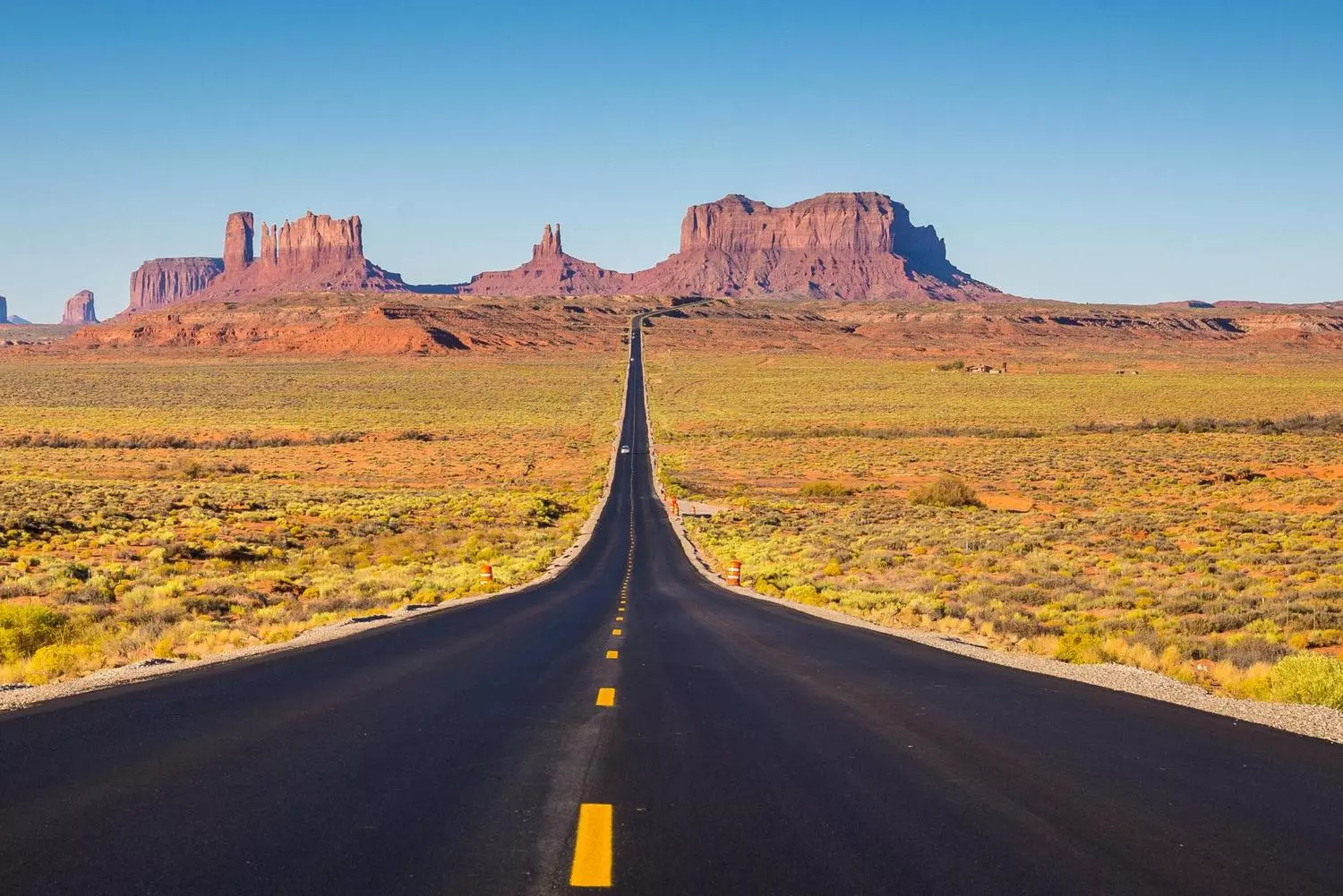
Navajo Culture and Traditions: The Heart and Spirit of Monument Valley
Monument Valley is not just a scenic landscape that captivates photographers and travelers from around the world. It is a living culture, the territory of the Navajo (Diné) people, where history and modern life intertwine at every turn. Walking among the red rocks, it’s important to remember: every stone, every monolith is part of sacred land, preserved and respected for centuries.
- 01. Living connection with the land
For the Navajo, Monument Valley is a place of power. It is called Tsé Biiʼ Ndzisgaii, which translates to “valley of rocks resembling mountains.” Each peak, crevice, and hill carries the history of the ancestors.
Local legends tell that spirits live in the rocks, and some stone pillars are petrified figures of mythical beings and warriors guarding the valley. These stories are passed down through generations, with elders teaching youth respect for the land, traditions, and the Navajo language. - 02. Ceremonies, dances, and rituals
The Navajo still perform traditional ceremonies in the valley, many of which are connected to natural cycles, the sun, the moon, and seasonal changes. Among them:
- Healing Ceremonies
Ancient rituals with chants and dances, using red sand as a symbol of life and earth. - Night Ceremonies under the Stars
Open-air rituals where celestial bodies are observed, and legends of spirits are shared. - Seasonal Dances
Dances accompanying harvest festivals or seasonal changes, with participants wearing masks and traditional costumes representing spirits and animals.
These traditions are not shows for tourists but a living culture, deserving respectful observation.
- 03. Tourism with cultural context
Today, many Navajo work as guides, offering tours that help visitors understand the valley from the inside. This goes far beyond just sightseeing:
- Jeep tours along hidden routes — beyond the official Valley Drive, opening secret spots known only to locals.
- Horseback rides — an opportunity to follow the trails once traveled by the Navajo ancestors.
- Night tours under the stars — storytelling about constellations and spirits visible in the valley’s clear night sky.
Every visitor, even those who stumble upon the valley by chance, feels the unique energy of the place. It is difficult to describe: the rocks seem to watch you, and the desert whispers legends.
- Photographers note that understanding the cultural context changes the perception of the landscape.
- Travelers say that tours with Navajo guides make the valley feel alive, not just a pretty picture.
- Researchers assert that respecting traditions allows for a deeper appreciation of the symbolism of each rock.
Fun fact: The Navajo do not call their sacred sites simply “beautiful” or “touristic.” Every peak and trail is a teacher. Even experienced travelers notice that after a guided tour, a new understanding emerges: each element of the valley is part of a living organism where history, myth, and nature are inseparably connected.
Legends and Myths of Monument Valley: When the Rocks Tell Stories
Monument Valley is not just rocks; it is a living universe, where every stone preserves ancient stories and secrets. For the Navajo (Diné), the valley is not just a landscape but a territory of spirits, warriors, and guardians of the land, passing wisdom and natural laws to anyone willing to listen.
- 01. Stone giants: the story of those punished by the gods
According to ancient Navajo legends, the majestic monoliths are petrified giants. They were proud and tried to climb to the sky, wishing to become equal to the sun. The gods punished them, turning them into stone so their pride would forever be etched into the landscape.
This is how The Mittens, Merrick Butte, Totem Pole, and other rocks came to be. For the Navajo, these stones serve as a moral lesson: strength and beauty can be great, but pride leads to downfall.
Locals claim that at sunrise and sunset, when the sun touches the peaks, you can “feel the breath of the giants” — a gentle wind gliding over the rocks, as if they come to life. - 02. Whispers of the guardian spirits
Another legend speaks of guardian spirits of the tribe, frozen in sand and stone to protect the Navajo from evil forces. When the wind whistles between cliffs, the Navajo say it is their whisper — a reminder of an ancient vow to maintain balance between earth and sky.
- Totem Pole
Believed to be one of the strongest protectors, its shape resembling a guardian raising its hands to the sky. - Yei Bi Chei
Another symbol of spiritual protectors, involved in healing rituals and seasonal ceremonies.
These myths create an incredible atmosphere: standing among the rocks, you sense the invisible presence of something ancient and powerful.
- 03. The valley as a school of humility
“Monument Valley teaches humility. Before its mountains, you feel like a grain of sand, yet that is what makes a person stronger.”
— words of a Navajo guide recorded in a travelers’ book.
Indeed, when gazing at the colossal rocks, one feels their own smallness in the face of eternity. At the same time, a sense of unity with the land and time emerges. The place reminds visitors that true strength lies in respect for nature and traditions.
Every traveler who hears these stories begins to view the valley not just as a beautiful landscape, but as a living place with a soul and history. Even a simple photograph becomes more than a frame — it becomes a small part of the legend.
- Legends explain the names and shapes of the rocks;
- Myths give each route special significance;
- Stories make tours with local Navajo guides not only informative but also spiritual.
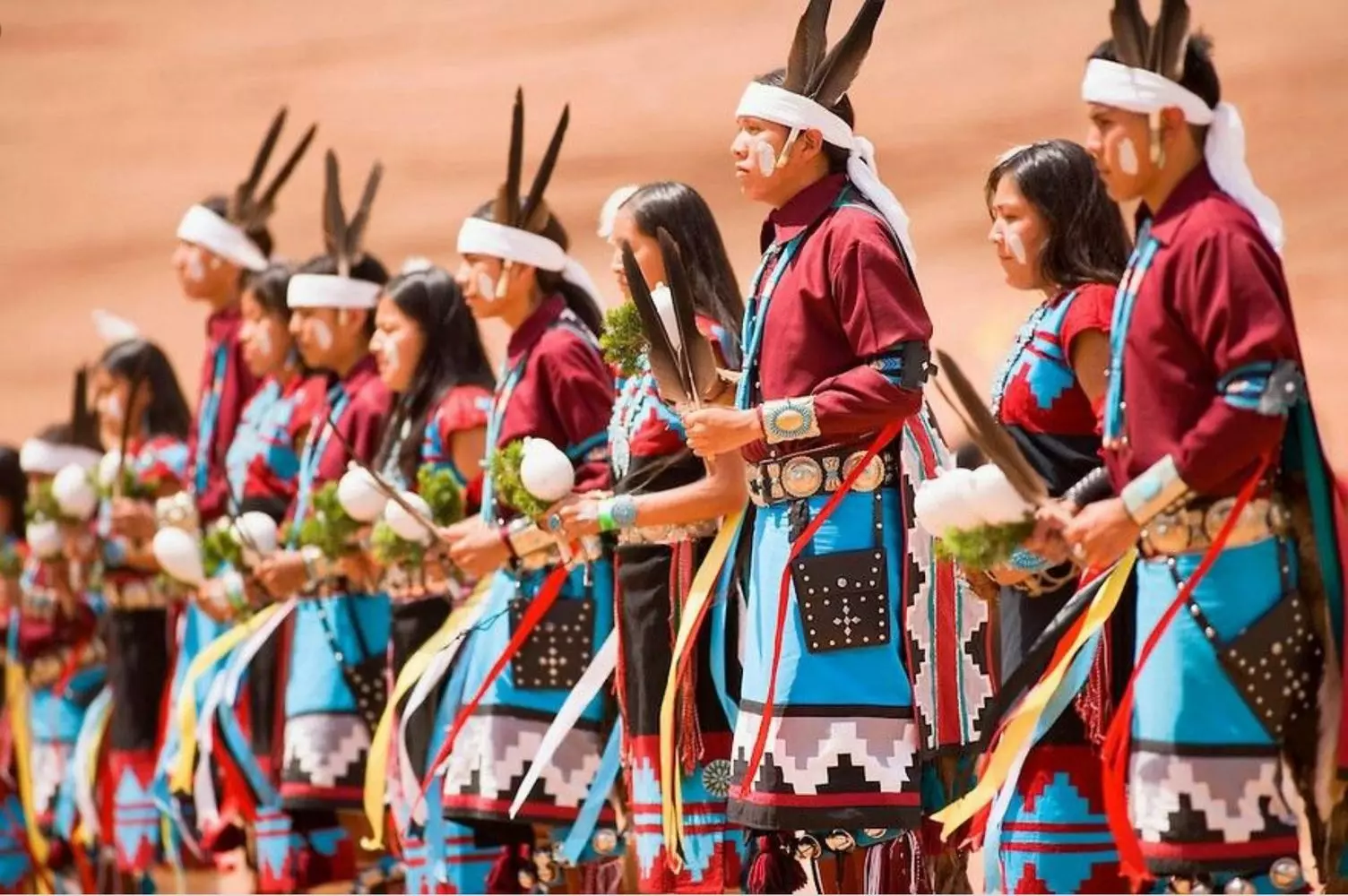
Where to Stay in Monument Valley: From Cliffside View Hotels to Authentic Navajo Homestays
When planning a trip to Monument Valley, it’s important to consider not just routes and excursions, but also where you’ll stay. The area offers options for every taste — from comfortable hotels with views of the monoliths to small guesthouses where you can immerse yourself in Navajo culture.
- 01. The View Hotel — sunrise right from your window
The most famous hotel is The View Hotel, located right at the entrance to the valley. It’s widely regarded as the best spot for those who want to see the legendary rocks every morning.
- Main feature: rooms with panoramic windows offering views of The Mittens, Merrick Butte, and Totem Pole.
- Sunrise magic: each day the rocks glow in fiery orange and purple hues — a unique natural show visible straight from your bed.
- Amenities: on-site restaurant serving local cuisine, gift shop, and guided tours with Navajo guides.
Early morning is the perfect time for photography. The light is soft, few tourists are around, and the landscape feels almost mystical.
- 02. Goulding’s Lodge — for history enthusiasts
Another popular option is Goulding’s Lodge, located near the valley. This complex is interesting not only for accommodation but also for its museum dedicated to the history of filmmaking in Monument Valley.
- You can see photos and props from John Ford’s films, and learn which scenes were shot in the valley.
- The complex also features restaurants, shops, and rental points for off-road vehicles to explore Valley Drive.
This is a great choice for those who want to combine comfort with the atmosphere of the Old West.
- 03. Campgrounds and RV sites — for freedom lovers
For those who prefer to stay closer to nature and on a budget, there are campgrounds and RV areas:
- Spacious plots within the reservation;
- Access to clean water and basic amenities;
- The opportunity to sleep directly under the starry sky — one of the clearest and most transparent night skies in the world.
This is a perfect way to feel the freedom and solitude of the desert, just like a character from an old Western.
- 04. Guesthouses on the reservation — an authentic experience
If you want more than just a place to sleep, staying in a guesthouse on the Navajo reservation offers a truly immersive experience:
- Simple yet cozy rooms;
- The chance to try traditional Navajo cuisine;
- Opportunities to meet local residents, take tours of their villages, and participate in craft workshops.
Staying in these homes is not only about accommodation but also about engaging with Navajo culture and traditions, making your trip genuinely unique.
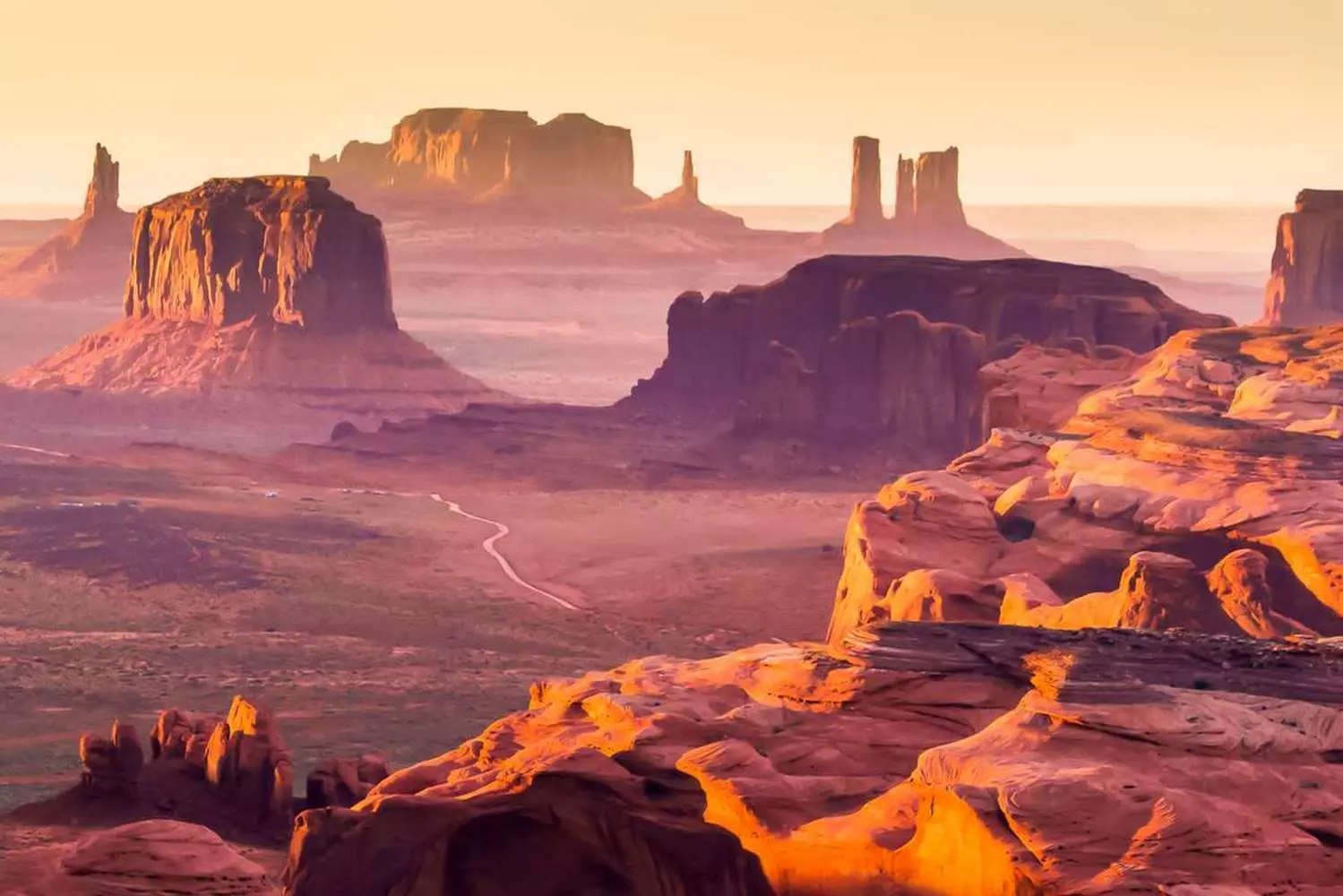
Routes and Activities in Monument Valley: How to Feel the Spirit of the Wild West
Monument Valley is a place that cannot be fully experienced in just one day. Every turn of the road, every rock, and every peak seems to tell its own story. To make the most of your visit, it’s worth planning your routes and activities in advance. Depending on your time and interests, you can choose a classic sightseeing route, a guided Navajo jeep tour, horseback rides, or night tours under the stars.
- 01. Classic Valley Drive — an introduction to the legend
Valley Drive is a 27-kilometer loop passing through the most famous and recognizable spots in the valley. The route is ideal for self-driving in an SUV or crossover. Along the way, you will see:
- The Mittens — two enormous stone “mittens,” the iconic symbols of the valley;
- Elephant Butte — a rock resembling the silhouette of a walking elephant;
- Three Sisters — three slender columns, like praying nuns;
- Artist’s Point — a viewpoint with panoramic views of the central valley;
- John Ford Point — the famous lookout where John Ford filmed his classic Westerns.
Time to complete: around 2–3 hours without stops. Photographers should plan a full day to capture the best light at sunrise and sunset.
- 02. Guided Navajo Jeep Tours — uncover the hidden secrets
To truly immerse yourself in Monument Valley, take a guided jeep tour with a local Navajo guide. These routes lead to areas closed to independent visitors, offering a glimpse of the valley that most tourists never see. What you’ll experience:
- Mystery Valley and Hunt’s Mesa — hidden canyons and plateaus, virtually untouched by visitors;
- Sacred sites and holy rocks inaccessible to regular tourists;
- Ancient petroglyphs — images left by Navajo ancestors, telling stories of life and spirits;
- Legends and songs of the Navajo people, adding a spiritual dimension to the tour;
- Film history — discover where iconic scenes of John Ford’s movies and other directors’ works were shot.
- 03. Horseback Rides — become a Western hero
For a true taste of the Wild West, choose horseback tours:
- Red dust beneath the horse’s hooves;
- Slow pace and majestic rocks all around;
- The feeling of being a character in an old cowboy movie;
- A chance to see the valley from a fresh perspective, different from the road view.
- 04. Night Tours under the Stars — the cosmos in your hands
Monument Valley is one of the best places in North America for stargazing:
- Almost no light pollution;
- The Milky Way is visible to the naked eye;
- Tourists can join guided night tours, learning about constellations and Navajo legends.
Bring a thermos of tea and a blanket — you can watch the stars for hours, enjoying the desert’s silence and the grandeur of the cosmos.
Tip from American Butler: we can organize a combined itinerary including a jeep tour, horseback ride, and photo tours at sunrise and sunset. This way, you’ll see Monument Valley from every angle and get a unique experience of every corner of the valley.
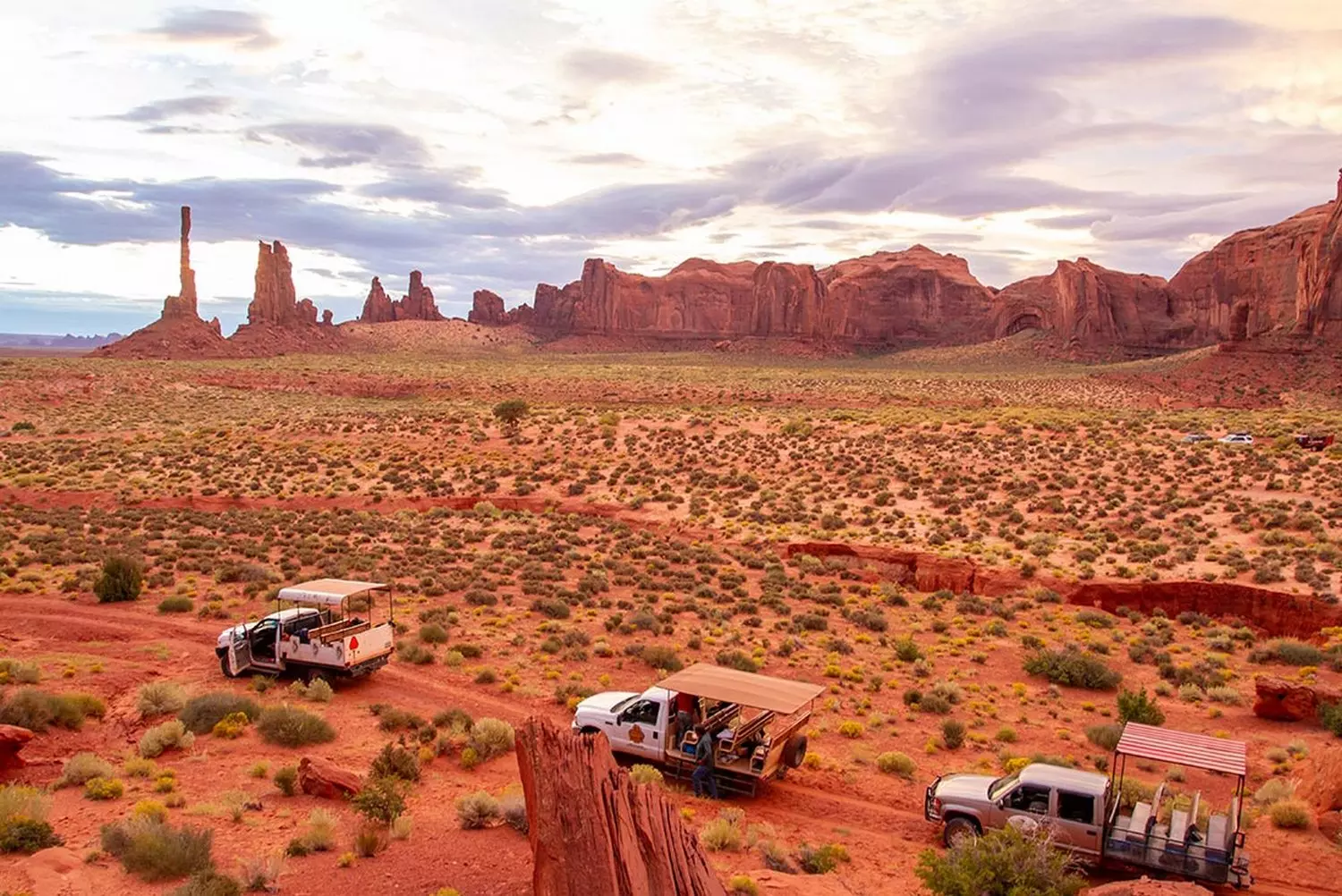
Culture, Respect for the Land, and Culinary Discoveries in Monument Valley
Monument Valley is not just a picturesque landscape for photos and films. For the Navajo people (Diné), this land is a living sacred site, a place of power and ancestral memory. When visiting the valley, it’s important to remember that it has its own laws, traditions, and restrictions, and following them is not a formality but a sign of respect for a culture that has endured for millennia.
- 01. Rules for respecting the land
Travelers should keep several key guidelines in mind:
- Do not climb on the rocks without permission
Many rocks and columns are considered sacred, and physically disturbing them violates ancient traditions. - Do not remove stones, sand, or other natural elements
Every grain is part of the land’s history and spiritual heritage. - Photograph people only with their consent
This is not just etiquette — it’s respect for individual and cultural rights. - No alcohol or loud parties
The valley is a place of silence and spiritual balance, where every sound is felt intensely.
- 02. Food and culinary discoveries
The Visitor Center has a small café where you can try traditional Navajo dishes:
- Navajo Taco — frybread topped with meat, beans, vegetables, and spices;
- Navajo Stew — a hearty meat stew, perfect for warming up after desert walks;
- Corn cakes and herbal tea — a traditional way to enjoy the flavors of the desert.
At souvenir markets and shops near the Visitor Center, you can find unique handmade items: silver jewelry with turquoise, pottery, miniature sculptures, traditional blankets, and sand paintings. By purchasing souvenirs, you support local artisans and help preserve the cultural heritage of the Navajo people.
- 03. Environmental responsibility
Monument Valley is a fragile ecosystem shaped over millennia. Preserving its beauty for future generations is the responsibility of every visitor.
- Do not leave trash behind
Any bottle or bag disrupts the natural balance. - Stay on marked trails
Sand dunes and rare plants are easily damaged underfoot. - Follow reservation rules and traditions
This is part of the cultural and natural heritage that cannot be restored once damaged.
Every crack in the rock, every sandy formation is the result of thousands of years of natural work. Our attitude determines whether future generations will be able to see Monument Valley as majestic and pristine as it is today.
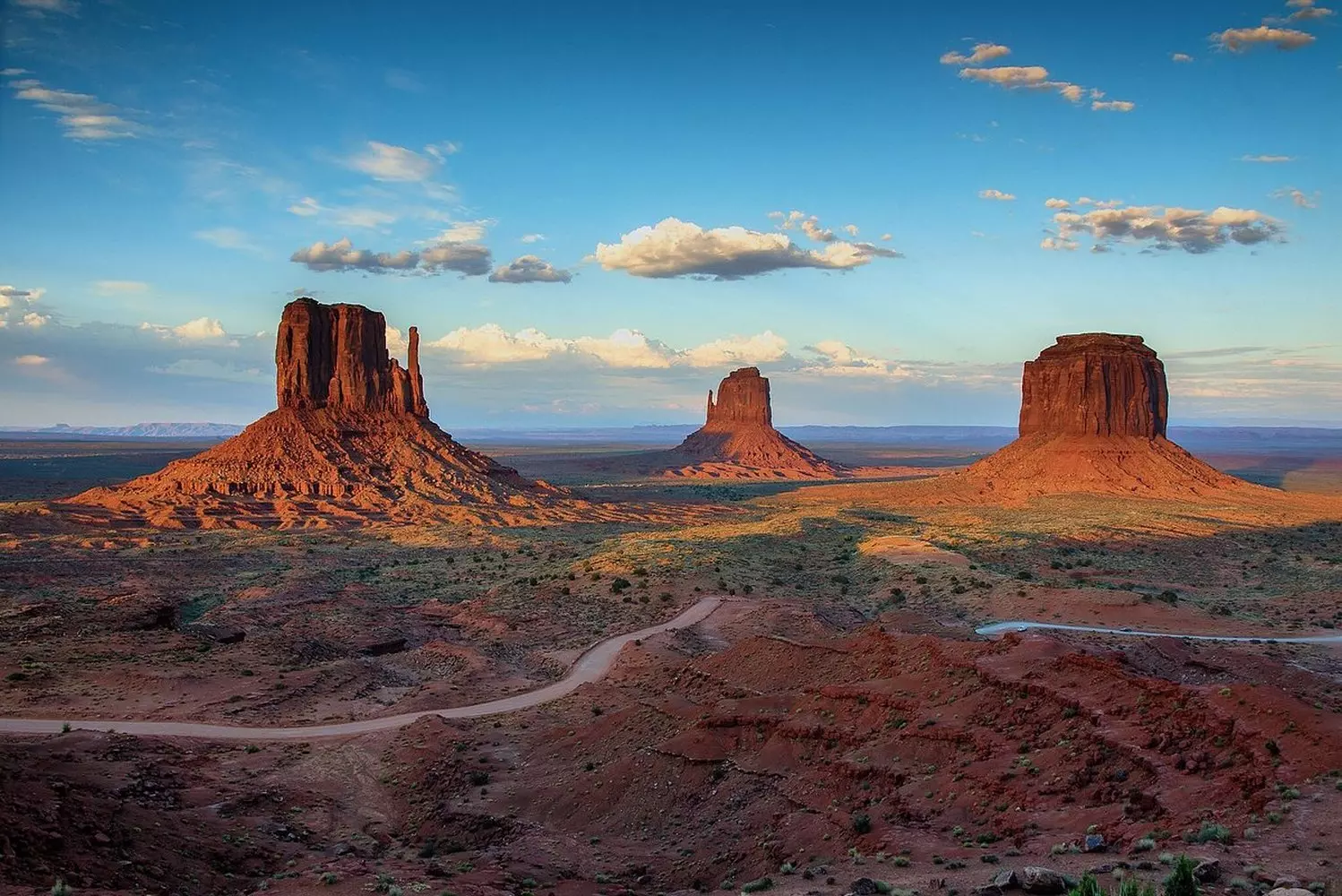
Monument Valley and Beyond: Routes and Attractions of the Southwestern USA
Traveling to Monument Valley is always a vivid and eventful part of a Southwest USA itinerary. But the valley itself is just the beginning of the adventure. Within a few hours' drive from Monument Valley, there are unique natural and cultural attractions that allow you to experience the spirit of the Wild West in all its glory.
- 01. Antelope Canyon
Just a 2-hour drive from Monument Valley is the narrow Antelope Canyon, famous for its wavy walls, light beams, and incredible interplay of light and shadow.
- Perfect for photo shoots and short walks;
- Accessible only with a guide — local residents lead tours and share the canyon's legends;
- An excellent opportunity to experience the magic of light among the red rocks.
- About a 2-hour drive from Monument Valley;
- A panoramic viewpoint offering breathtaking views of turquoise waters and red cliffs;
- An easy walking trail suitable for the whole family.
- 04. Lake Powell
A vast reservoir among red cliffs — perfect for water trips, kayaking, and relaxation.
- A great chance to combine desert landscapes with turquoise water;
- You can visit Antelope Point Marina or have a picnic by the shore;
- A boat trip provides a unique perspective of the canyons.
- 05. Grand Canyon National Park
3–4 hours by car, and you will reach one of the planet’s most magnificent natural wonders.
- The South Rim is ideal for hiking and panoramic viewpoints;
- It can be combined with a Monument Valley visit in one full day;
- Especially impressive at sunrise and sunset.
- 06. Canyon de Chelly
- About 2 hours away;
- A valley with ancient petroglyphs and cliff dwellings of the Navajo;
- Tours with local guides allow you to learn about the Diné culture.
- 07. Monument Valley Scenic Loop
- An alternative to the main Valley Drive loop;
- A less touristy road revealing hidden views of Totem Pole and Mystery Valley;
- Perfect for jeep tours and photography.
- 08. Traditional Navajo towns and villages
- Kayenta, Arizona — the nearest town with shops, cafes, and a Navajo museum;
- Mexican Hat, Utah — a small town with the eponymous sombrero-shaped rock;
- Page, Arizona — a town where you can combine visits to Antelope Canyon, Horseshoe Bend, and Lake Powell.
- 09. National Parks and Monuments
- Navajo National Monument — ancient cliff dwellings;
- Glen Canyon National Recreation Area — for water sports and nature enthusiasts;
- Monument Valley Tribal Park — exclusive routes and cultural tours with a Navajo guide.
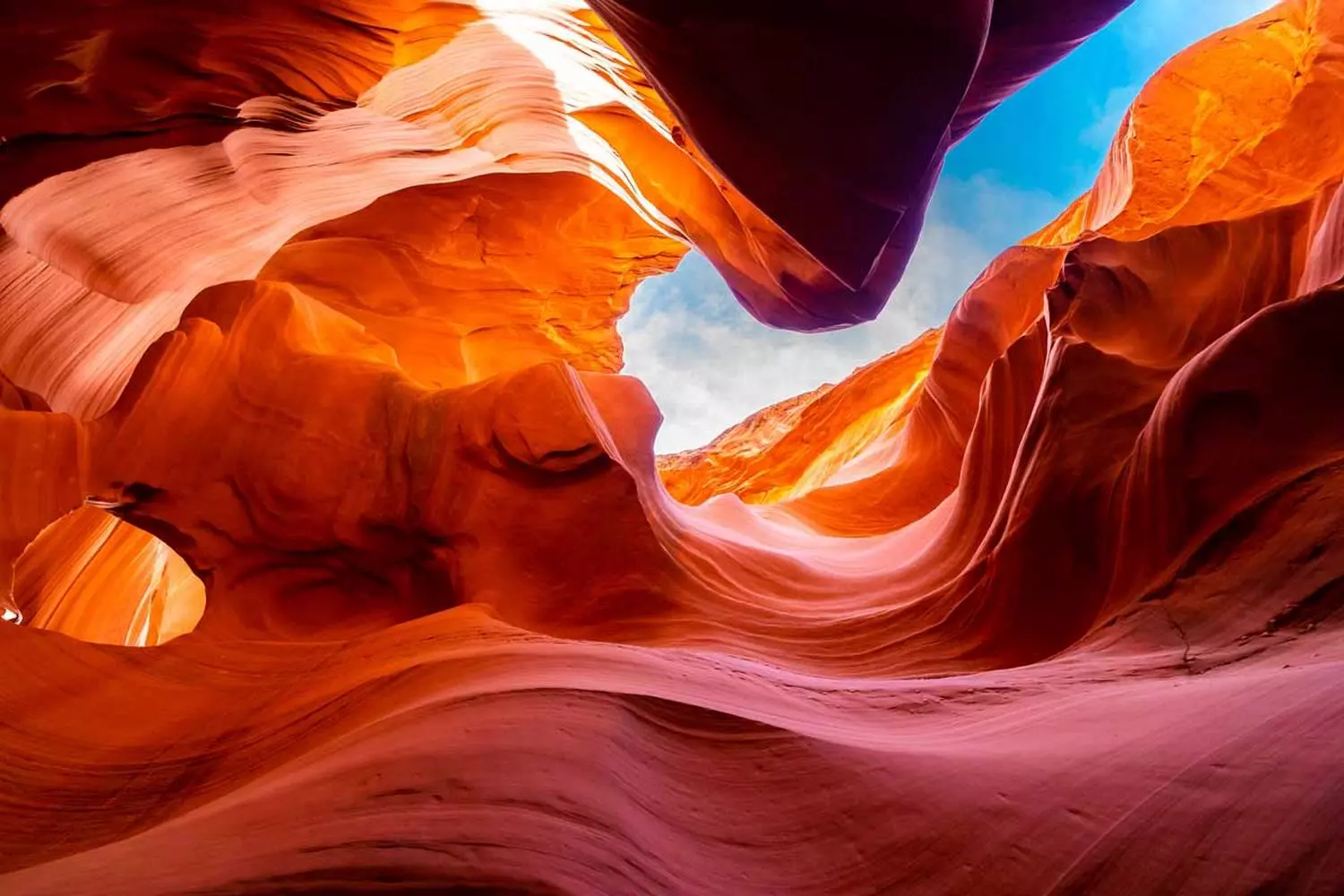
Monument Valley: 10 Facts You Didn’t See in the Movies
Monument Valley is one of those landscapes that is recognizable at first glance. It feels as if you’ve been here before, thanks to dozens of Westerns and commercials. But behind this familiar facade lies a world of amazing paradoxes and secrets that movie cameras keep silent about. Discover the real Valley — the one that exists beyond the Hollywood frame.
- 01. It’s not a valley, but an ancient “dump”
From a geological perspective, Monument Valley is not a classic river valley, but part of the vast Colorado Plateau. Its famous giant rocks are nothing more than remnants left after millions of years of erosion. Scientists joke that it’s a geological “garbage dump”: everything soft has been washed away or eroded, leaving only the strongest and most resilient sandstone “monuments” that we see today. - 02. Giants that… move
It seems these stone giants have stood still forever. In fact, they are in constant, albeit very slow, motion. Rain, wind, and temperature fluctuations continuously erode the formations. Their outlines change, and the “monuments” gradually “shift” across the desert, moving away from the spot they occupied centuries ago. This process is invisible to the human eye, but over thousands of years, Monument Valley is a dynamic rather than static landscape. Someday, these giants too will fall, making way for new landforms. - 03. A voice that silences everyone
Monument Valley has a phenomenon of absolute silence. Due to the unique terrain and the lack of vegetation to absorb sound, you can experience one of the loudest silences on the planet. When the wind stops, you can hear your own heartbeat. This almost otherworldly acoustic vacuum encourages speaking in whispers and listening to your inner sensations, turning a visit to the valley into a meditative experience. - 04. The world’s largest “souvenir” that almost got stolen
In the 1950s, an entrepreneur from New Mexico had an ambitious and insane plan: he wanted to… take one of the monoliths (West Mitten Butte) for his tourist complex. The plan was to dismantle the rock with dynamite, transport it, and reassemble it. Fortunately, the vandalistic project never came to fruition due to protests from the public and the Navajo tribe. Yet the idea shows just how hypnotic and coveted this land can be. - 05. An astronaut who trained for Mars without leaving Earth
Due to its otherworldly landscape, Monument Valley served as a training base for NASA. Apollo missions were practiced here in the 1960s, and later preparations for Mars landings were conducted. The geological features and isolation were considered an ideal model for testing procedures in alien environments and prototyping rovers. This land thus became a bridge not only between cultures but also between planets. - 06. Twin rocks that aren’t really twins
The famous “Mittens” (East and West Mitten Butte) appear perfectly symmetrical only from one, most popular viewpoint. Move around them, and you’ll see that they differ in shape, size, and even tilt. This optical illusion is nature’s clever trick and a masterclass in composition that Monument Valley offers every photographer. The perfect shot requires not just pointing a camera, but finding the single spot where the magic fully manifests. - 07. A silent chronicle of an apocalypse, etched in stone
Fossils found in Monument Valley are not just ancient shells. They are evidence of a global catastrophe. Fossilized tree trunks lying horizontally and other findings indicate a massive flood that literally “wiped out” forests and buried them under layers of sand and silt millions of years ago. Walking through the valley is like walking through a giant “graveyard” left from a prehistoric cataclysm that laid the foundation for today’s landscape. - 08. The valley discovered by… a postman
Monument Valley wouldn’t have become an iconic symbol of the Wild West without Henry Weathers, a half-Navajo postman. In the 1920s, he was among the first guides to take rare tourists here in his old Ford. He introduced these locations to director John Ford, convincing him to shoot the first film here. Weathers not only knew every trail but also personally participated in scouting locations, becoming the godfather of Monument Valley as a movie star. - 09. Sand that “sings”
In certain parts of the Valley, you can witness a rare acoustic phenomenon — “singing” or “ringing” sand. When the wind blows at a specific angle, or when walking on a particular type of fine, dry quartz sand, a low hum resonates, resembling the sound of a passing airplane or a distant organ. The Navajo considered this sound the voice of spirits, while scientists explain it as friction between uniformly sized sand grains. This is one of the most mystical and little-known “special effects” of the Valley. - 10. A sanctuary for “living fossils”
Despite the harsh climate, the Valley is home to remarkable creatures. Among them is the desert-dwelling tree lizard, which changes color depending on the ambient temperature, and so-called “living fossils” — endemic plants whose ancestors grew here during the time of the dinosaurs. These species have survived thousands of years of climate change, adapting to life in the shadow of the stone giants.
So, how will it appear to you? As a geological dump, sacred Navajo land, a Hollywood set, or a Martian plain? Monument Valley offers no definitive answers; it asks questions. To hear them, you must stand beneath the shadow of its giants, touch the singing sand, and attempt to unravel the mystery of light that has persisted for millions of years. All the facts are merely a prelude to your personal discovery.
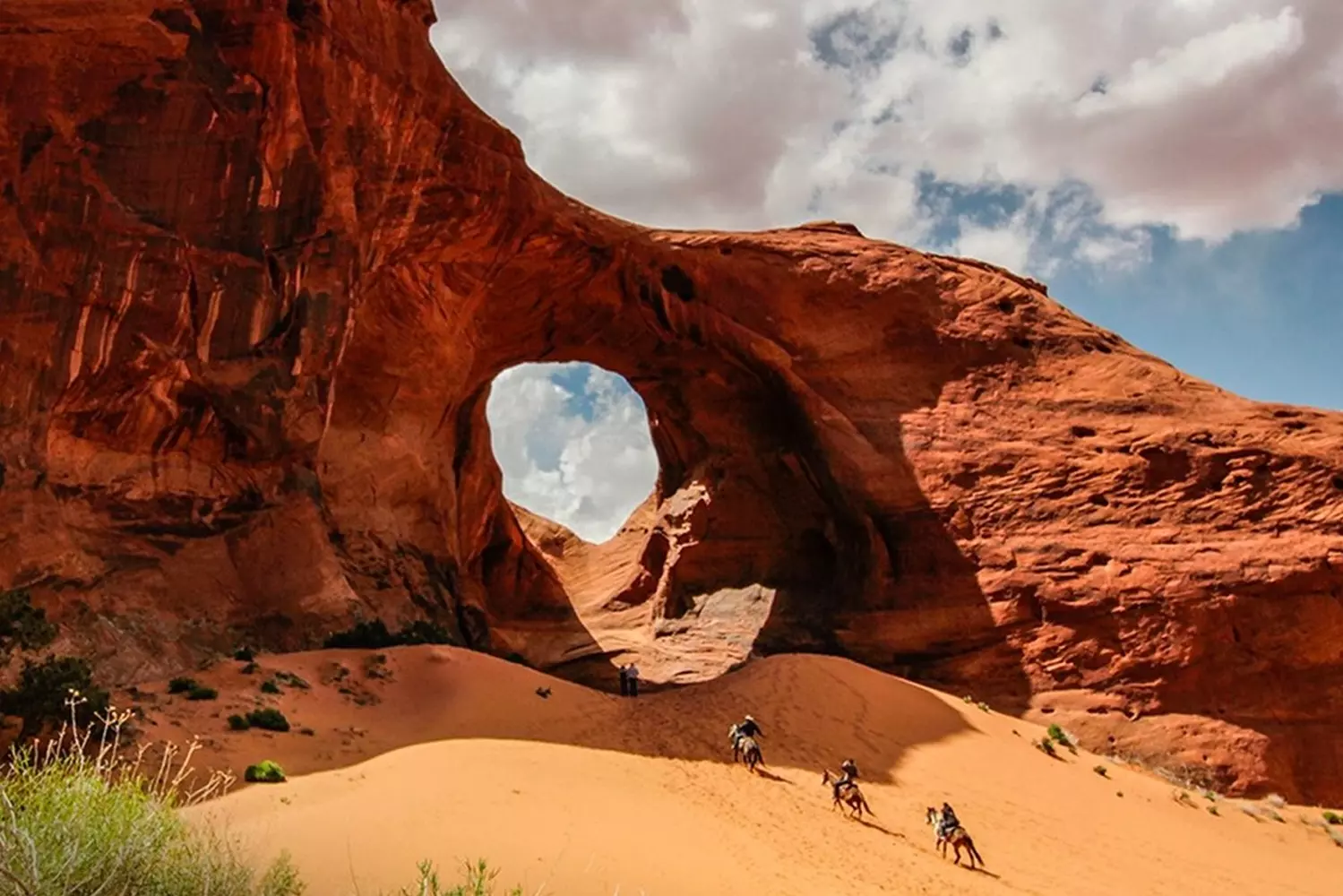
How American Butler Assists Travelers
Monument Valley teaches the most important lesson — to see not only with your eyes but with your heart. Modern life makes us run: from deadlines, from routine, from the city. But the Valley makes you stop. Here, you cannot rush — and you wouldn’t want to.
Many return from their trip changed. Some say they learned to appreciate silence. Others say they felt gratitude toward the Earth for the first time. And some simply realized that true luxury is the ability to be here and now.
American Butler is an expert in personalized trips across the USA. We create itineraries that let you see America not through the eyes of a tourist, but through the eyes of an explorer. Here’s what we can organize for your journey to Monument Valley:
- Private transfers from any city (Las Vegas, Phoenix, Los Angeles);
- Assistance with renting an SUV;
- Selection of a professional guide;
- Accommodation in the best hotels of the region;
- Combined itinerary: Monument Valley + Grand Canyon + Antelope Canyon + Horseshoe Bend;
- Photo and video tours for bloggers and travelers.
Monument Valley is a place where even the air sounds different. Everyone who visits takes home not only photographs but also a sense of inner silence.
To understand America without Monument Valley is like reading a book while skipping the first chapters. If you feel the call of the road, if you have ever dreamed of seeing that sunset over the red desert — it’s time to take that step.
American Butler will help you turn your dream into reality. We will craft an itinerary filled with meaning, comfort, and the magic of a true journey.














